
The Indiana State Department of Agriculture (ISDA) submitted an inventory of lost farmland report to the Legislative Council. In 2023, the Indiana General Assembly passed House Enrolled Act 1557, which tasked ISDA to complete an inventory of lost farmland in Indiana from 2010-2022.
ISDA determined through the inventory of lost farmland that there has been an overall reduction of farmland acres of approximately 1.5-2% from 2010-2022. This represents a loss of approximately 350,000 acres. The results show that agricultural land was most likely to be lost in areas around the edges of cities and suburban areas. The primary cause of reduction in farmland was due to residential use.
“Agriculture is, and always has been, the lifeblood of the Hoosier state,” said Lt. Gov. Suzanne Crouch, Secretary of Agriculture and Rural Development. “Data is critical for all levels of government when making decisions that may affect our rural communities and food security.”
ISDA used two sources of data – (1) parcel data from the Indiana Department of Local Government Finance(DLGF) and (2) the United States Department of Agriculture (USDA) National Agricultural Statistics Service (NASS) Crop Data Layer (CDL). Both datasets have different qualities that make them desirable for attempting to discern both the quantity of land use change and the causes of land use change.
“The inventory of lost farmland was an opportunity for ISDA and legislators to gain access to reliable data, where up until now, we could only make assumptions,” said Don Lamb, director of the Indiana State Department of Agriculture. “This information is important to have for policy development as we work to balance economic growth, food security and the preservation of agricultural land, because we know when agriculture is strong, Indiana is too.”
Despite the loss in acreage, yield data from USDA NASS shows that Indiana’s production of its cash crops has increased. In 2012, Indiana produced over 597 million bushels of corn for grain, and in 2022 yielded over 1 billion bushels. Indiana produced nearly 219 million bushels of soybeans in 2012 and saw that number increase to over 326 million in 2022.
ISDA outlined several recommendations within the report to the Legislative Council, including that legislation be passed directing ISDA to update the inventory of lost farmland every five years, starting in 2029 for a report to be published in 2030.
To view the full 2010 to 2022 report or narrative, click here or visit isda.in.gov.
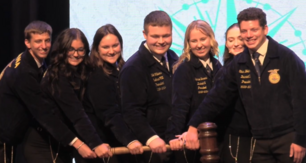
During the 95th Indiana FFA State Convention, 12 FFA members from across the state participated in a rigorous interview and selection process.
The following members were selected to serve Indiana FFA and its 13,000+ members as a 2024-25 Indiana FFA State Officer:
• President – Ethan Wolheter, Prairie Heights FFA
• Secretary – Christina Caldwell, Connersville FFA
• Northern Region Vice President – Stephanie Berenda, South Newton FFA
• Southern Region Vice President – Cale Williams, Terre Haute South FFA
• Treasurer – Kyatalin Baker, Switzerland County FFA
• Reporter – Sienna Alexander, Monrovia FFA
• Sentinel – Garrett Bolin, Indian Creek FFA

Weekly Review for June 21, 2024
This informal report by the Division of Entomology & Plant Pathology is a commentary on insects, diseases, and curiosities division staff encounter on a week-to-week basis. Comments and questions about this report are welcome and can be sent to your respective Inspector.
Our Website
Inspector Territories
Announcements
1) Indiana DNR’s 2024 Spongy Moth aerial treatments were completed as of Monday, June 17. Please visit our spongy moth website for more information on our treatment program.
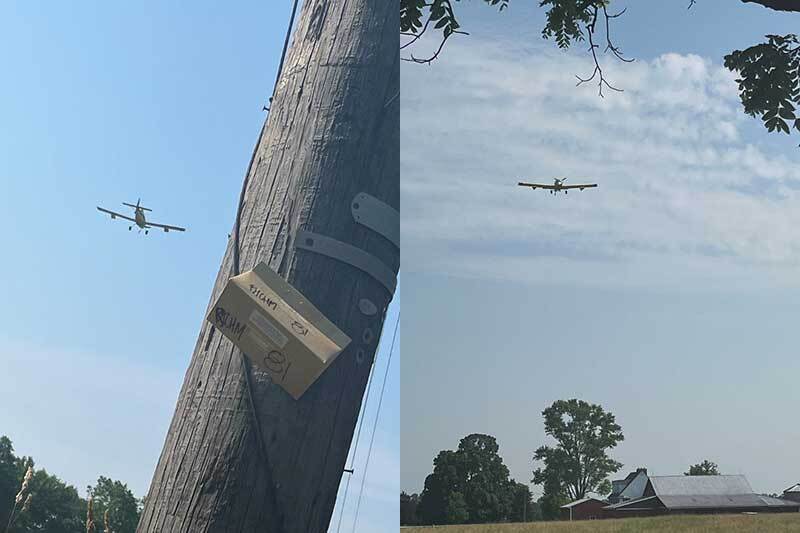 |
Photos: Spongy moth mating disruption treatment in Richmond, Indiana (photos by Jared Spokowsky)
2) Nursery inspector Will Drews received an award from SICIM (State of Indiana Cooperative Invasives Management) for his work with terrestrial invasive species at the 2024 Indiana Invasive Species Conference at Brown County State Park. Congratulations Will!
Reports
Diane Turner (Nursery Inspector & Compliance Officer) –
I have recently been seeing a good amount of red-headed flea beetle, Systena frontalis, damage specifically on hydrangeas in nursery production throughout Indiana. This small insect is about 1/6 inch long with a metallic black oval body and a reddish-yellow head. As the name suggests, this flea beetle jumps when disturbed, like a dog flea.
Adult beetles feed on the leaves of a wide variety of popular ornamental shrubs like hydrangea, azaleas, rhododendrons, weigela, and roses. Although the leaf-feeding rarely harms overall plant health, plants with a significant amount of damage are often too unsightly to sell.
 |
Left: Red-headed flea beetle, Systena frontalis, adult on hydrangea (Hydrangea spp.) Right: Feeding damage caused by the adult red-headed flea beetle on hydrangea leaves.
Kristy Stultz (Nursery Inspector & Compliance Officer) -
A lot of Christmas tree growers also dig nursery stock. While doing an inspection for one such establishment, I noted tags from last season. It’s important to remember to remove those tags, especially if they’re snugged on tight like this one. It won’t take that branch long to girdle itself.
One of the best things about inspecting any type of nursery is the opportunity to stop and smell the roses, or in this case, stop and watch a hover fly enjoy field sowthistle. Someone should enjoy this non-native flower.
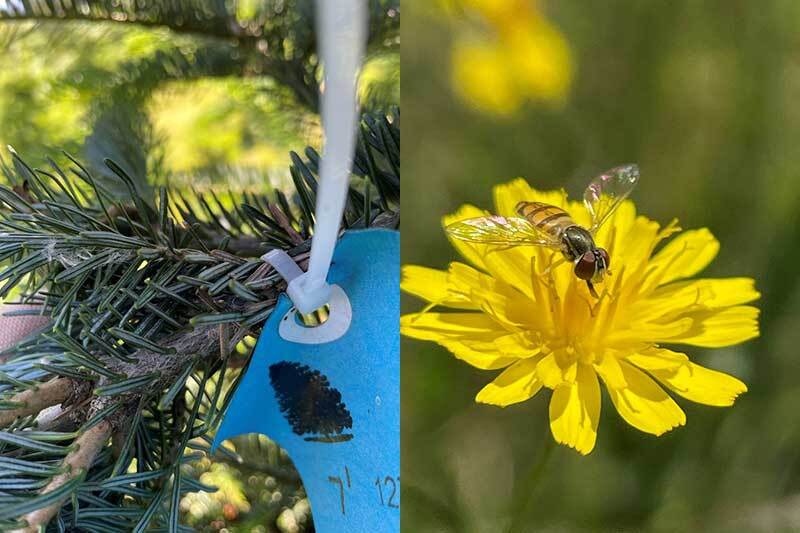 |
Left: Forgotten tag on Christmas tree which can lead to girdling. Right: Hover fly on non-native field sowthistle.
Jared Spokowsky (Nursery Inspetor & Compliance Officer) -
I wish I could say I had some good news for once but as I usually tell people if I show up it’s not good news. The first research paper confirming Tropilaelaps mites in western Russia on Ukraine’s border was released last month. You can read the whole paper (its only two pages) at this link. After Varroa every beekeeper should be familiar with this. It’s not in the western hemisphere yet but its pattern of spread indicates it could be in short order. There are very few people in positions like mine across the country so it’s most likely going to be found by a beekeeper first. Without early detection and reporting we have little chance of eradication before it becomes established. Currently the only thing that works at controlling these mites is formic acid and brood breaks.
I’ve been taking so many photos of what bees are working while doing inspections I am going to start to unload some more of them here. At the end of the season, I hope to put a complete list together with a few notes on preference.
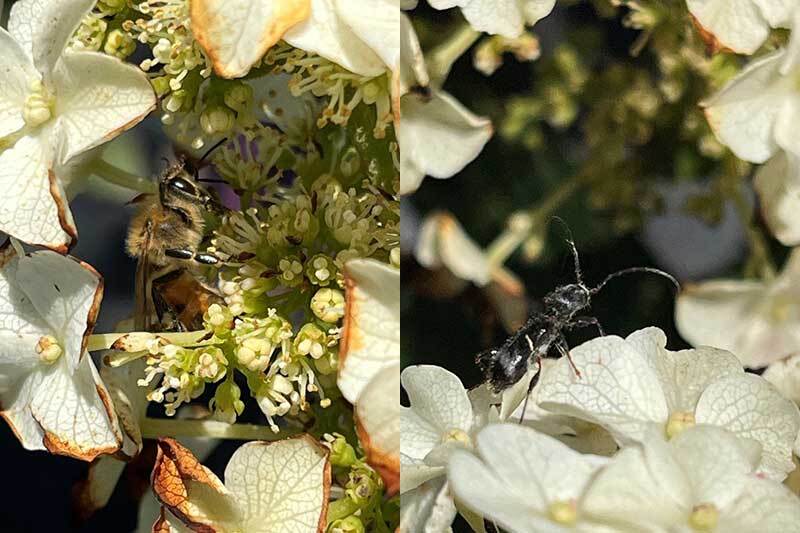 |
Left: Honeybee on Quickfire Hydrangea (I was quite surprised how much activity this had). Right: Quickfire hydrangea also had quite a bit of other insect activity including this longhorned beetle.
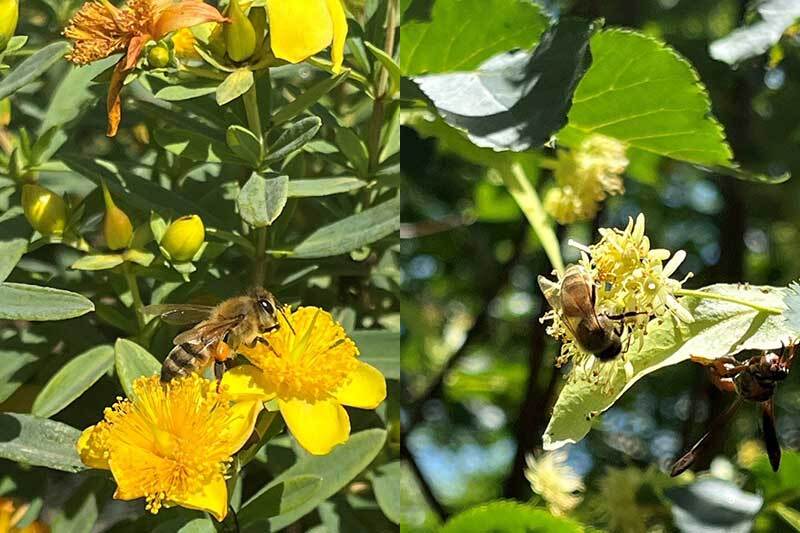 |
Left: Honeybee on Blue Velvet St. John’s wort (Sunburst is also a common variety that gets a lot of activity, I think all St. John’s wort does for that matter). Right: Honeybee and a paper wasp on a linden.
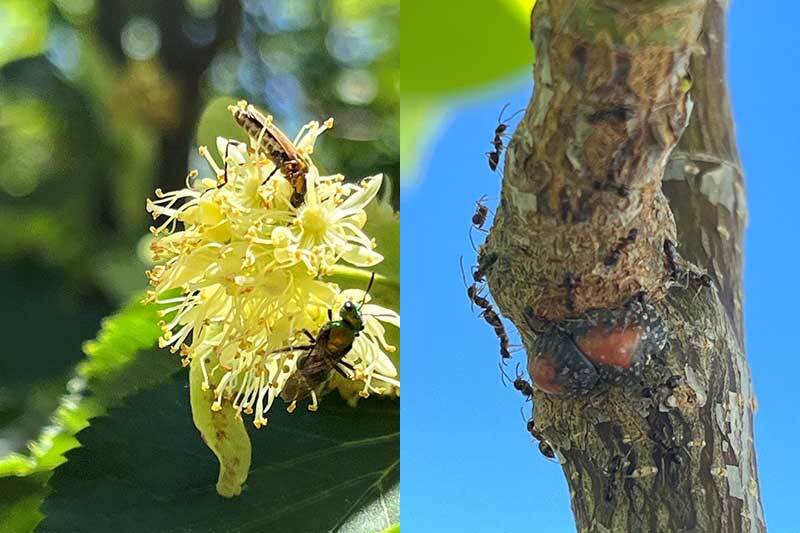 |
Left: Lindens attract quite a few insects including this soldier beetle and green sweat bee. Right: tuliptree scale.
In addition to bees I’ve seen a few other issues on nursery stock including tulip tree scale on tulip poplar, fall webworm on redbud, rose rust, fire blight on ninebark, quince rust on service berry, Japanese beetle, cottony maple scale and ambrosia beetles.
 |
Left: Fall webworm on redbud. Right: Rose rust (top of leaf).
 |
Left: Rose rust (bottom of leaf). Right: Rose rust close up.
 |
Quince rust on serviceberry.
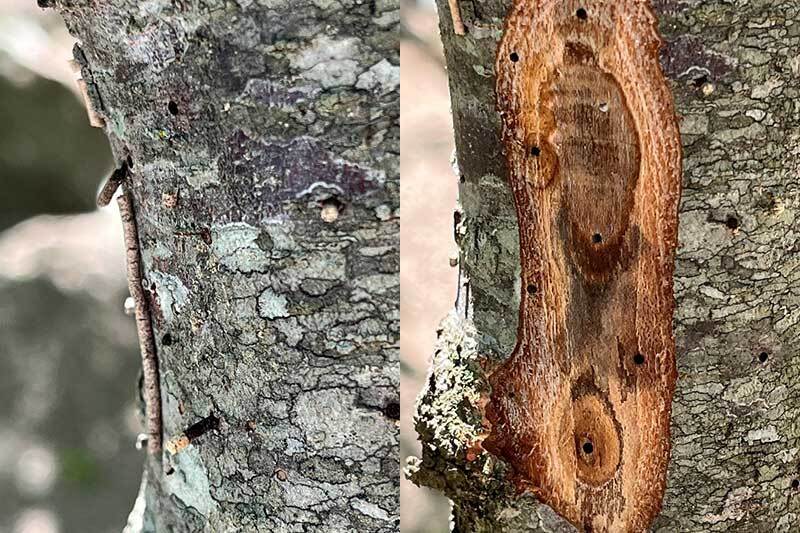 |
Ambrosia beetle damage and the same area showing the bark removed to see the hole more clearly.
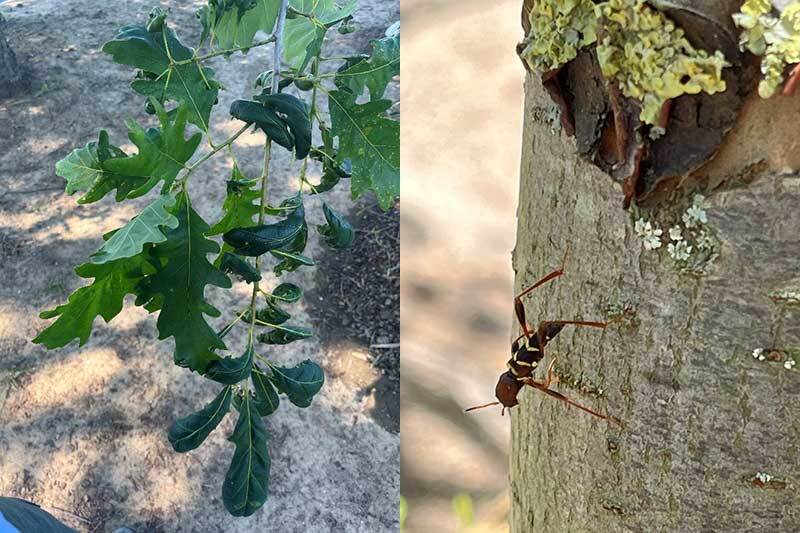 |
Left: White oak in a landscape with herbicide damage. I have noticed a marked increase in this type of damage since Dicamba resistant soybeans were released. This was not a nursery tree but an established landscape tree next to the nursery. Right: Redheaded ash borer. This is a native ash pest which can cause significant damage to ash but this is the first time I have seen it in quite a few years.
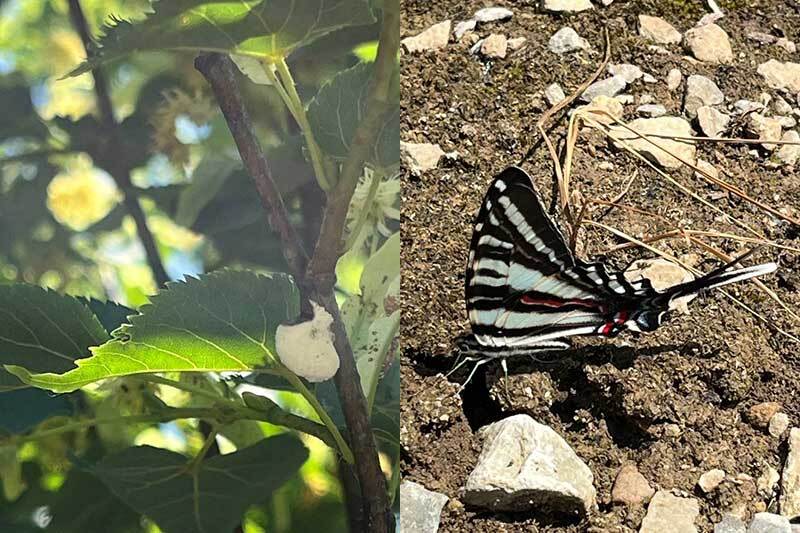 |
Left: Cottony maple scale on linden. Right: Zebra swallowtail. The host for this butterfly (which is one of our most impressive IMO) is the paw paw. I tend to only find these in VERY close proximity to paw paw. But I did have a nursery owner who planted a bunch of paw paw and within a couple years he had them flying around the nursery so I guess you could say “plant it and they will come.”
Eric Biddinger (Nursery Inspector & Compliance Officer) -
I have heard a meteorologist call our current weather pattern a “flash drought.” With that in mind, irrigation should be on everyone’s mind. Along with increased watering, be on the lookout for leaching and nutrient deficiency issues, especially in smaller containerized stock.
While working through a Christmas tree farm last week, I spotted this droopy white pine. Turns out this was white pine weevil damage. So often we catch this critter in the second year after the center leader is already dead. At this point, the larvae were already down to the next node and have already caused significant structural damage to this tree.
 |
White pine weevil damage.

The best small farm field day in Indiana is Thursday, July 25, 2024 at the Purdue Student Farm (1491 Cherry Lane, West Lafayette, IN. 47906) starting at 8:00 am.
Topics include: food safety updates, packhouse tours, weed & insect management, crop production, and more. Register online at: https://am.ticketmaster.com/purdue/smfarm.

Weekly Review for May 29, 2024
This informal report by the Division of Entomology & Plant Pathology is a commentary on insects, diseases, and curiosities division staff encounter on a week-to-week basis. Comments and questions about this report are welcome and can be sent to your respective Inspector.
Our Website
Inspector Territories
Jared Spokowsky (Nursery Inspetor & Compliance Officer) -
We are short on time but if anyone wants to submit their colony loss data for this year, the Apiary Inspectors of America and Auburn University are doing a colony loss survey. However, it’s only open until Friday, May 31.
Also, anyone interested in using oxalic acid extended-release strips I would encourage you to go to this website. Betterbee is going to be the sole distributor for Varroxsan, an oxalic acid impregnated strip that is labeled for extended use to control Varroa mites.
Kristy Stultz (Nursery Inspector & Compliance Officer) -
There seems to be a lot going on with roses this spring. Several dealer locations have had material showing heavy signs of rose mosaic virus. Symptoms can be variable since there are several viruses that contribute to the disease complex. I don’t remember ever seeing so many different symptoms on the same plant. One mode of transmission is through grafting or budding infected material onto healthy plant stock or vice versa. When receiving stock from any source, take some time to look it over. There’s no easy cure for rose mosaic virus. Sanitation of tools is important to remove the risk of spread to uninfected stock as well.
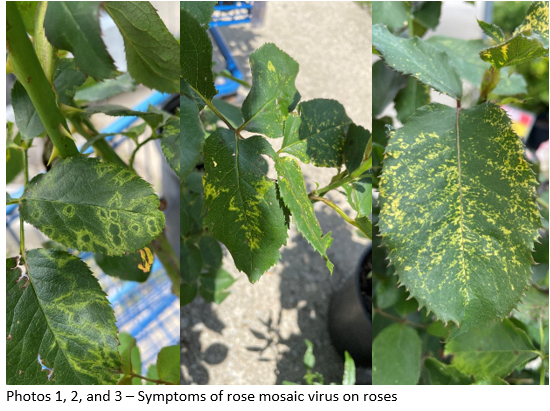
Eric Biddinger (Nursery Inspector & Compliance Officer) -
There has been all kind of talk about cicadas this year with the co-emergence of Brood XIII (a 17-year brood) and Brood XIX (a 13-year brood), though the ranges of these two broods do not overlap. On top of that, there are reports of some early emergence of Brood XIV (expected in 2025) and Brood XXIII (expected in 2028) occurring. There’s not much going on in my neck of the woods, but on a recent trip to Valparaiso I was blown away by the volume (noise) and volume (quantity) of cicadas.
As far as landscape damage is concerned, cicadas pose the largest risk to small and newly planted trees. While it is a little late to take protective measures such as netting, scouting trees for flagging and other signs of stress should continue throughout the summer, even after the cicada songs have faded away. For more information about all things cicada, visit cicadamania.com.
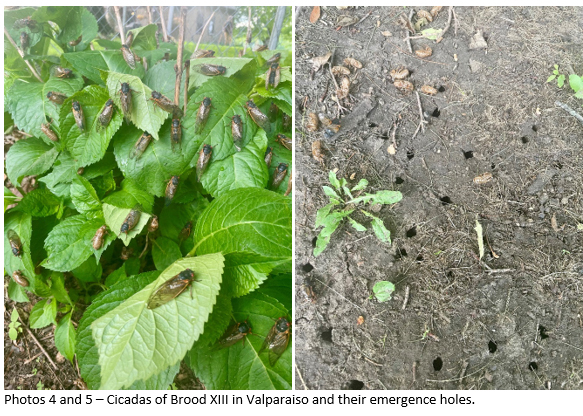
SalemLeader.com
Leader Publishing Company of Salem, Inc.
P.O. Box 506
117-119 East Walnut Street
Salem, Indiana. 47167
Phone: 812-883-3281 | Fax: 812-883-4446
Business Hours:
Mondays through Fridays, 9:00am - 5:00pm
News:
news@salemleader.com
Office:
office@salemleader.com
Publisher:
publisher@salemleader.com
Business
- More Business News
- Go To Guide
- Business Directory
- Auctions
Education
- More Education News
Opinion
- Editorials
- Letters to the Editor
- Columns
- Unsung Heroes
- Days Gone By
- In the Garden
- Guest Columns
- Reader's Poll
- Salem Leader Forum
- Questions and Answers
Church
- Bible Aerobics
- Church News
- Church Directory

